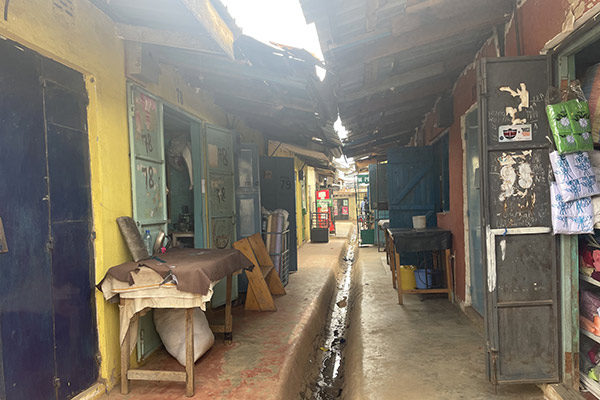A Glimpse into Urbanization in the Slums
By Yuchan Wang, MBA ’24

Children playing football in the Kibera slum, Nairobi, Kenya (photo by Yuchan Wang)
Kenya currently boasts one of East Africa’s most thriving markets, accompanied by rapid urbanization. China experienced a similar process two decades ago. During my internship with the United Nations in the summer of 2023, this phenomenon piqued my curiosity, leading me to explore the lives of ordinary people amidst this rapid urbanization.
During my spare time, I frequently volunteered in Kibera, Nairobi’s largest slum. In the midst of Kenya’s fast-paced urbanization, Kibera reached a peak of 1 million residents. Learning this statistic left me astounded; it revealed that in some African cities, slums are no longer “marginalized”; they are mainstream.
According to my local tour guide, in Swahili “Kibera” means “forest” or “jungle.” It was established in the early 20th century when the British government granted Kenyan soldiers the right to settle on public land near the railway. Today, the forest has vanished, and Kibera has become a temporary refuge for rural migrants seeking work in the city, representing the intersection between rural and urban life. People often view cities as the future in linear development and rural areas as the past. However, if we adopt this perspective, slums like Kibera represent both the past and the future; they are the present.
This “present” is highly fluid. Most residents of Kenyan slums are employed in the urban service sector. Every morning, tens of thousands of people stream from Kibera into the city for work, only to return to the slum in the afternoon. Jobs are generally unstable, resulting in thousands of people arriving from rural areas each month and an equal number leaving.
This high level of mobility poses challenges for the government in managing the slums. Their approach is ambiguous, desiring to provide stable employment opportunities while avoiding the long-term preservation of the squalid living conditions in the slums.
Consequently, they have created well-facilitated “commercial zones.” Here, one can find areas of recent government-owned construction and renovation with clothing stores, schools, barbershops, markets, art workshops, and auto repair shops. Shopkeepers pay regular rent. They serve as showcase projects, displaying the new face of the slums. However, the residential areas tell a different story. They lack access to piped water, forcing locals to purchase 25-liter jerrycans of water for 20 Kenyan shillings each (equal to around 1/15 of daily income for an ordinary worker in Kibera slum).
With scarce space and exorbitant water prices, most households share public toilets, which are locked and require a fee of 5 to 10 shillings to unlock. Locals claim the government hasn’t connected electricity to their homes, and even if it did, they couldn’t afford it through official channels. Instead, they pay a monthly “protection fee” of 300 shillings per household to local “gangs” that illegally tap electricity from the city’s main lines or other infrastructure.
Residents pile garbage into waste mountains, which the government collects irregularly, sometimes every two to three months or as infrequently as every four to five months. Dogs scavenge on the garbage heaps while children play soccer nearby.

Due to the lack of government support for waste management, Kibera’s residents have formed self-help organizations. During the UN Habitat Assembly, I encountered the community organization Slums Going Green and Clean, dedicated to plastic waste recycling. They collect discarded plastic water bottles and other plastic products from households, heat-press them into plastic boards, and use these to create tables and chairs.
Due to Kenya’s plastic ban, acquiring raw materials is challenging, so they must go door to door every two weeks, charging a fee of 20 shillings for each collection. While helping with the garbage collection, I happened to pass the home of a 17-year-old employee of the organization. Despite his home being adjacent to the slum’s sewage canals, he had kept it remarkably neat. He told me, “Yes, my home is organized because I believe if my home is organized, my future will be too.” This quote has stayed with me ever since.
The struggle against plastic in the slums
When discussing plastic, we cannot ignore Kenya’s strict plastic ban. In August 2017, Kenya implemented one of the “world’s toughest” bans on plastic bags, prohibiting the manufacture and use of all retail plastic bags without approval from the National Environmental Management Authority (NEMA). Offenders—both manufacturers and users—faced fines of up to 6.3 million Kenyan shillings. In a country with an average monthly income of only 63,000 to 79,000 shillings, such fines were exorbitant. This strict ban nearly eradicated retail plastic bags in Kenya. A friend specifically warned me not to carry plastic bags in my luggage when flying to Kenya, as it could result in hefty fines.
During my visits to the slums, I noticed that most local residents approved of this policy. As previously mentioned, the majority of toilets in the slums are fee-based and in short supply. To avoid these costly facilities, residents had resorted to collecting waste in plastic bags, sealing them, and disposing of them in ditches or by the roadside—a practice infamously known as the “flying toilet,” contributing to cholera and malaria outbreaks in the slums, while domestic animals, such as cows and sheep, often ingested plastic bags, leading to their deaths.
Air quality in the slums saw relative improvement. Due to limited landfill space, some residents would set fire to trash at night, producing noxious fumes. After the implementation of the plastic ban, the fumes seemed to disappear.
Nevertheless, the plastic ban cast a new shadow over the already challenging lives of slum dwellers. The ban resulted in the loss of approximately 60,000 jobs and the closure of at least 176 manufacturers. Some small business owners complained that using eco-friendly bags increased their costs. To save on expenses, some shops resorted to packaging products in old newspapers, raising new hygiene concerns. Additionally, questions arose about the environmental friendliness of the alternatives to retail plastic bags. While Kenya’s government stipulated that bags with handles and flat packaging were no longer allowed, it did not specify the acceptable alternatives. In the same year, a new type of “fabric-like bag” appeared at Kenyan supermarkets.
These “fabric-like bags” are made from non-woven polypropylene, a material that, despite its name, is essentially plastic. Compared to traditional plastic retail bags, these bags are less biodegradable and may not guarantee the same level of food safety.
Ordinary citizens are often unaware of these underlying issues. Once, while purchasing a bag at a retail supermarket, I asked the cashier what the bag was made of. She told me it was a cotton bag, harmless to the environment. In reality, I knew this bag was even less environmentally friendly than the plastic bags it replaced.
In the global urbanization process, Kenya’s rapid emergence in the market is just a microcosm. Cities offer easier access to employment and services but also amplify inequality, leading to the expansion of slums and exacerbating poverty and environmental issues. Balancing stable business development in emerging markets with the improvement of local well-being is a challenge that I believe entrepreneurs of our generation must address if they are to truly contribute to society.
About Yuchan Wang, MBA ’24

Yuchan Wang is a class of 2024 student in the Two-Year MBA program at the Samuel Curtis Johnson Graduate School of Management and an Emerging Markets Institute fellow. She was able to pursue her internship with the United Nations in the summer of 2023 thanks to the Social Impact Internship Fund provided by the Johnson School. As a student she has focused on sustainable global enterprise and emerging markets and she is particularly interested in impact investing to create a more sustainable and humanistic life for all. Before attending the Johnson School, she was an architect, entrepreneur, and assistant professor. She designed and coordinated affordable housing projects and encouraged her students to promote social sustainability.
